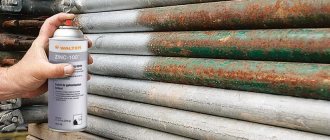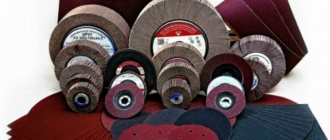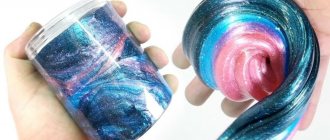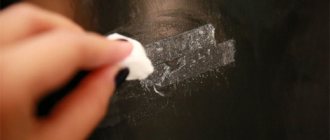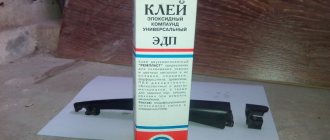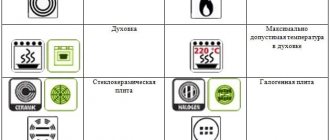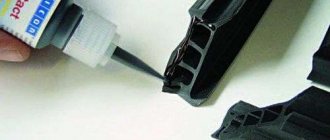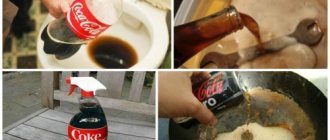We are surrounded by many different metal structures, which include iron fences, garages, buildings made of metal profiles, galvanized steel, benches, swings for children, various communications, and so on. Metal products are painted in different colors, they are durable and attractive. However, in order for them to be reliably protected from rust and corrosion, a metal primer must be used, which significantly extends the service life of structures.
Some, unfortunately, neglect the priming process when performing interior or exterior work, believing that purchasing a primer is an unreasonable expense. However, everything is quite the opposite; if you do not use soil, there will be the following negative consequences:
- paint and varnish materials will not adhere very firmly to the surface, and under the influence of the environment they will gradually begin to delaminate, peel and crumble;
- freshly painted buildings or products will begin to become covered with rust spots after some time;
- Without using a primer, the consumption of varnish or paint will significantly increase.
Main advantages of priming
Thanks to the use of a good, high-quality primer, the negative impact of various factors is minimized, metal surfaces are protected and the service life of products is extended. In addition, metal primer provides the following advantages:
- the primer improves the quality and adhesion of the decorative coating to the structure;
- makes metal more durable;
- metal products acquire reliable protection from the destructive effects of rust;
- When painting metal, paint and varnish materials are saved.
Experts say that it is much better to take the time to perform priming work during routine repairs before painting, and postpone the next repair for a long time. Moreover, now you can buy a quick-drying type that significantly saves priming time. Primer costs much less than regular painting after a short period of time, and the financial costs of repairing metal products, so primer is a must.
Advantages and disadvantages of soils
Despite the fact that the primer is not visible at the end of the work, both the quality and durability of the completed painting depend on it. After high-quality coating application, the following are guaranteed:
- protection against rust and corrosion;
- smooth substrate for painting;
- presentable appearance of the car;
- there are no reasons for cracking, bubbles and subsidence in the enamel.
What primer should be chosen to achieve this is up to the car owner to decide for himself, but one piece of advice from the experts is worth listening to. The point is that you cannot skimp on this mixture.
You should choose proven brands: only in this case can you count on getting a high-quality result.
Cheap primers are dangerous because during drying they shrink unevenly, which leads to disruption of the evenness of the coating, loss of appearance, the formation of cracks and the formation of rust.
Types of primers
Today in markets and stores there are many types of primers for applying to metal for painting. In order for the result to be as effective as possible, you need to approach the choice of primer for metal responsibly and select the most suitable composition. There are these types of primers for metal:
- primer for non-ferrous metals, such as aluminum, copper, brass. A primer for these metal surfaces enhances adhesion and makes adhesion to the base better and more reliable. These primers are also used for processing galvanized steel;
- for ferrous metals such as iron and cast iron, as well as steel and iron alloys. The primer significantly slows down the process of oxidation or rusting, because these materials quickly undergo the corrosion process. In addition, the adhesion of paints and varnishes to the base during finishing painting is enhanced;
- for galvanizing. The best primer for metal made of galvanized steel is a composition based on organic solvents, and mixtures for processing non-ferrous metals have also proven themselves;
- For ferrous metals that have traces of rust, you need to use special rust converters, which contain certain chemical components that react with rust and turn it into a durable layer. Such primers are capable of restoring a damaged surface; to work with these compounds, you do not need to first clean the metal of rust, you just need to remove the contaminants on the surface;
- special primer mixtures used against various stains on metal surfaces that do not absorb moisture. These soils block contaminants, which include grease stains, traces of soot, etc. These compounds are used if it is not possible to clean the contaminants. If they are not primed, then some time after painting the paintwork materials will begin to peel off in these places.
What is the best primer for metal? Popular manufacturers
There is no clear answer to the question of which primer is best for metal. Because, firstly, primers for metal have different purposes. Secondly, preferences vary from person to person. The best primer is the one that meets the desired requirements better than all others.
Tikkurila OTEX
SPECIAL METAL Primer
NOVAX Anticor “3 in 1” glossy
GF – 021
PF – 021
Nerzhamet
PRODECOR
Spray KUDO
The production of primers that protect metal surfaces is constantly developing, both abroad and within the country.
Domestic manufacturers are constantly improving, using both foreign experience and their own unique developments. And as this process intensifies, buyers are increasingly choosing domestic goods. Table 2. Popular primers for metal from leading manufacturers
| Soil name | Brand and manufacturers | Type | Average price in rubles per kg |
| Tikkurila OTEX | Tikkurila | Alkyd | 794 |
| SPECIAL METAL Primer | Hammerite | Transformative | 1650 |
| GF – 021 | TEX, LAKRA | Insulating | 120 – 129 |
| PF – 021 | SpetsEmal LLC, etc. | Alkyd | 84 |
| Nerzhamet | "KrasCo" | Alkyd-urethane “3 in 1” | 320 – 360 |
| PRODECOR | "Russian Paints" | Alkyd | 211 — 307 |
| Spray KUDO | "Russian technical aerosols" | Alkyd | 300 |
| NOVAX Anticor “3 in 1” glossy | GOODHIM | Alkyd | 334 |
It is worth noting that reviews of the presented products are approximately equally positive, regardless of whether it is a foreign or domestic brand. At the same time, the prices offered by domestic manufacturers are much more pleasant.
Types of primer compositions
The most common primers for metal processing are the following mixtures:
- alkyd primers for metal. They are most often used in comparison with other types. They are made on the basis of alkyd varnish material, to which various stabilizers and additives are added. Mixtures may be brown or gray. They belong to the category of quick-drying and fairly durable primers, protect the metal base both inside and outside, create a strong base that can be coated with almost any finishing material;
- primers based on orthophosphoric acid are usually used for those structures that already have rust. These primers effectively eliminate corrosion by creating a protective layer and restoring the surface, resulting in significantly improved adhesion. With the use of such mixtures, it is possible to effectively strengthen the damaged base, stopping corrosion processes;
- acrylic primers make it possible to level the base and increase adhesion. These water-dispersible soils have a minimum drying time and are classified as quick-drying. Acrylic primer for metal is completely safe for human health, it can be used indoors, and is suitable for application to both ferrous and non-ferrous metals. Not all acrylic mixtures can be painted; for example, paint will not apply evenly to acidic primers, so acidic primers are applied if paint and varnish material is not used in the future;
- Passivating primers significantly slow down corrosion processes and are applied to metal products exposed to the open air. These compounds perfectly protect structures from the harmful effects of the atmosphere; their special composition is designed in such a way that they continue to protect the metal surface even when moisture or water breaks the protective film;
- Epoxy primers effectively protect against high humidity and negative atmospheric influences. An epoxy primer for metal is used for processing any metal structures, as well as cars.
Requirements for the solution
A quick-drying solution is applied to metal structures to provide an optimal surface for finishing. Among the purposes of the mixture are the following:
- Ensure adhesion between surface and finish
- Provides protection against corrosion and premature failure
It should be remembered that some types of paint do not require prior priming. These include heat-resistant and organosilicon, since the formation of an additional layer between them leads to delamination. Primers that are used for metal require strict selection, since most of them are used only for certain types of paintwork materials.
Important! For ease of application, manufacturers produce aerosol cans that do not need to be diluted and can be easily sprayed with your own hands.
What is important to consider when buying a primer
Regular primer or primer paint for metal should be selected taking into account climatic conditions if they are to be used for outdoor work. And if the primer is used for interior work, then it is important to take into account the toxicity indicator, especially when priming is performed in a residential building. In addition, when choosing primer products, the following nuances must be taken into account:
- what material will be treated with a primer – colored or black;
- is there a certificate confirming the high quality of the product;
- the soil is intended for internal or external work, can it be subject to mechanical load;
- what type of finishing coating will be applied;
- what is the primer consumption per 1 m2 of metal.
It is also necessary to pay attention to the form in which the products are produced, and what tool will be used to process the base:
- if a spray gun is used, then you need to buy a liquid composition. You can also purchase a powder or concentrated product, which is diluted according to the instructions using a solvent or plain water to the desired consistency. Using the spraying method is effective for large metal structures, extensive iron sheets. It is important to remember that water-dispersion-based mixtures are quick-drying, so the next layer must be applied almost immediately, but only after the previous layer has dried;
- If the primer on metal will be applied with a roller, then any release form will do. The roller applies the mixture quite economically and distributes it evenly;
- a brush can also be used to apply the mixture, however, this method is the most expensive and uneconomical. Using a brush, hard-to-reach places and small areas are treated;
- aerosol cans are very convenient to use, however, they have a small volume and are much more expensive than formulations in cans or canisters. If you treat large areas, you will have to buy a lot of spray cans.
When purchasing a primer for metal, you need to read the instructions and take into account the consumption per square meter. Depending on the consumption, you need to calculate how much soil will be needed to process the entire structure. In addition, if the composition contains toxic substances, then it is immediately important to purchase personal protective equipment, such as gloves, goggles and a respirator.
Rules for priming metal for painting
When priming metal structures, a number of rules and recommendations must be followed.
Calculation of material consumption
The required amount of materials is usually indicated on the packaging. Specific parameters are influenced by the composition, temperature and humidity, and characteristics of the surface being treated.
Required Tools
To prime the metal you will need:
- roller;
- brush;
- spray gun;
- container for soil.
Surface preparation and preparation of working solution
At the surface preparation stage, it is necessary to clean it. To do this, dust particles and contaminants are removed from the metal. You also need to get rid of rust-damaged areas. This makes it possible to apply primer and paint more evenly.
Applying primer
Before using the soil, you must read the instructions. Application may require a roller, brush or spray. Layers need to be made as thin as possible. It is better to increase their number. The primer must be completely dry before applying the finish. If required, the coating can be made rough. To do this, it is recommended to use sandpaper.
Layer drying time
The following factors influence the drying time of the primer:
- Surface quality. On dry and porous surfaces, the material dries much faster. To speed up the process, you can degrease the soil before using it.
- Temperature and humidity. The optimal parameters include +15-20 degrees and 60-80%. Before applying primer, the room must be ventilated. After using the substance, this should not be done, as the surface may become cracked.
- Layer thickness. The more layers are applied, the longer the primer takes to dry.
- Composition of the mixture. Materials that contain solid components or easily volatile solvents dry much faster.
Alkyd types of primer are considered the best option for treating metal surfaces. They take 10-12 hours to dry.
Application Features
In order for the primer to perform its functions as effectively as possible, it must be applied correctly. It is important to adhere to the following recommendations:
- Before you start applying the mixture to the metal surface, it is important to thoroughly clean it of any contaminants, including remnants of old paint, dirt, traces of corrosion and rust. If a rust converter is used, it does not need to be removed from the surface;
- when old, dried paint is very difficult to remove from the base, you can use a special softener. When it is applied to old paint materials, they are very easy to clean off the surface;
- When all contaminants have been removed, it is important to sand the base until it shines, and then rinse it. If non-ferrous alloys are processed, they do not need grinding; it is enough to wash and dry them well;
- Before you start priming the metal, if necessary, you need to degrease the base; this should be done in the presence of greasy, oily stains. Degreasing is carried out either with special electric machines or with ordinary cotton cloth and degreasers, such as solvents. Thanks to this procedure, the metal adhesion rate will be significantly increased;
- After preparing the base, priming of the metal begins on a clean and dry metal surface. The primer liquid is distributed over the base in a thin layer; puddles or drips should not be allowed to appear. When the first layer has dried, subsequent layers can be applied. Experts recommend applying two thin coats rather than one thick coat of primer;
- After the last layer has completely dried, you must immediately begin treating the structure with finishing paints and varnishes. If this is done after a few days, dust may settle on the surface, which will significantly reduce adhesion, and the quality of adhesion of the paint to the product will deteriorate.
If you follow the stages of performing the above work and carefully, slowly prime the metal base, the metal structure will be qualitatively protected, its service life will be significantly extended, and the metal surface will receive high-quality protection from aggressive and adverse environmental influences.
